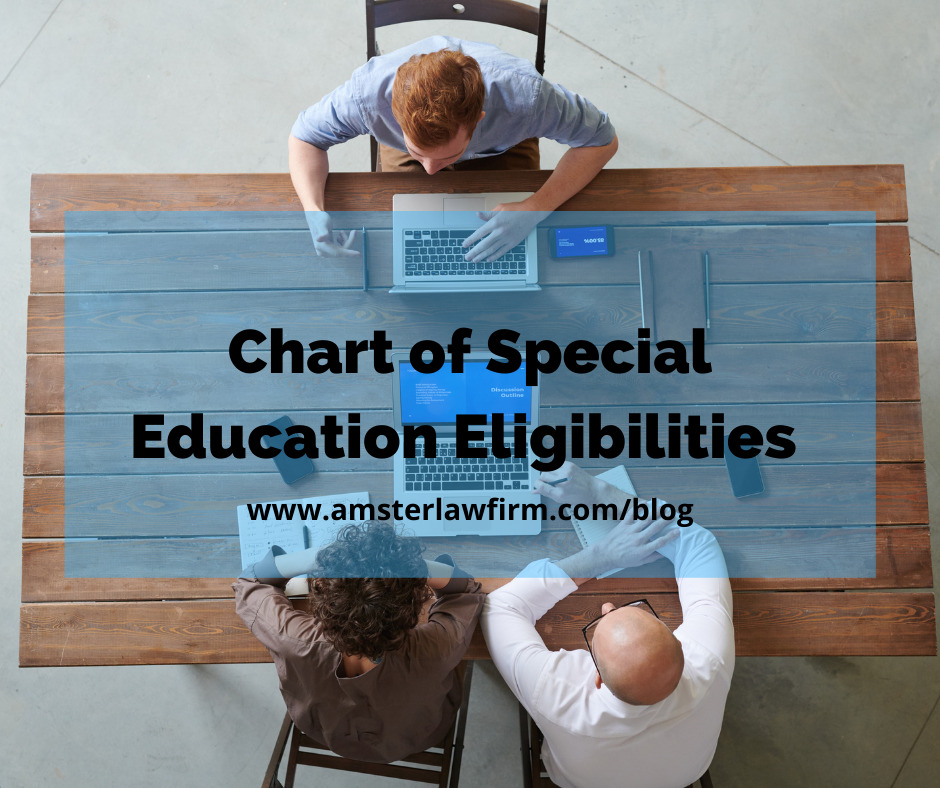School Districts are required to provide special education services for a child with a disability if the disability falls within one or more of 13 categories addressed by IDEA and the child needs special education services. The following chart is only a general outline of a broad range of characteristics associated with the 13 disabilities that are included under IDEA. This chart will help in your initial IEP or whenever eligibility is discussed at an IEP.
The eligibility should be discussed by the entire team and it is an IEP team decision. The school psychologist can give his or her opinion, but ultimately it is a team decision. The eligibility should be the eligibility that best describes the student. If another eligibility also explains the student’s disability then that should be included on the IEP. Some IEPs have space for secondary eligibility or it can be included in the notes section.
Child’s Characteristics | IDEA Classification |
The child may struggle with communication difficulties and social contacts. The child may exhibit repetitive behaviors, struggle with changes to the environment or routine, and have heightened responses to sensory stimuli. | Autism |
The child may have difficulty following conversations and may struggle with perception. It may be difficult for the child to pick up social cues from the expressions and actions of others. It may be necessary for the child to hold books very close to his or her face, as the child may struggle to see. | Deaf-Blindness |
Hearing impairment gets in the way of the child’s communication and learning, even when amplification is provided. | Deafness |
One or more issues related to mental health or behavior may disrupt the child’s learning over time, even with additional support and assistance. These may include anxiety, bipolar, obsessive-compulsive disorder, and more. | Emotional Disturbance |
The child may experience permanent or intermittent hearing loss that limits the ability to take lecture notes, join in group discussions, and develop vocabulary. | Hearing Impairment |
The child’s general functioning, adaptive behavior, and cognitive functioning is appreciably below average, resulting in potential difficulties with speech, personal care, and learning. | Intellectual Disability |
Two or more severe disabilities—one usually an intellectual disability—limits the child’s educational performance. | Multiple Disabilities |
Congenital, hereditary, or developmental impairments, or those related to disease or other issues, negatively impact the child’s performance in school. This may include a wide array of disabilities, such as cerebral palsy, muscular dystrophy, scoliosis, amputations, and more. | Orthopedic Impairment |
Critical health issues impair the child’s educational performance. A range of conditions include, but are not limited to: ADD/ADHD, asthma, diabetes, epilepsy, heart conditions, leukemia, and Tourette syndrome. | Other Health Impairment |
One or more psychological processes get in the way of the child’s learning, resulting in difficulty with spelling, reading, writing, oral expression, mathematical skills, reasoning, and memory. | Specific Learning Disability |
The child has difficulty communicating due to any of a number of conditions, including but not limited to stuttering, lisping, abnormal pitch or resonance, improper syllabication, and blocks of silence. | Speech or Language Impairment related to voice, fluency, language, or articulation |
The child may experience a wide array of issues, ranging from difficulties with abstract thinking, short- or long-term memory deficiencies, limited attention span, and comprehension and problem-solving challenges. | Traumatic Brain Injury |
The child may have difficulty moving about the room, reading, utilizing software, or conceptualizing objects. | Visual Impairment |


Add Comment